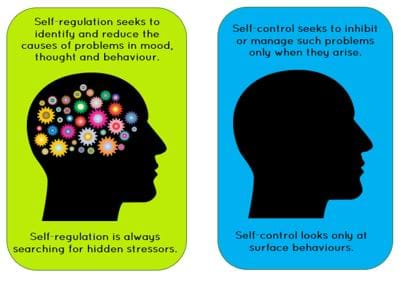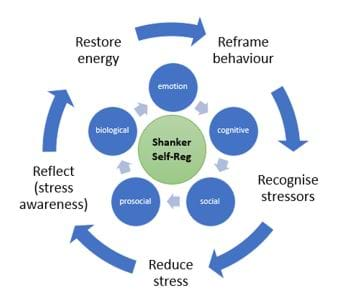Supporting Self-Regulation in the Early Years

Dr Stuart G. Shanker is a research professor of Philosophy and Psychology at York University and the Founder/CEO of The MEHRIT Centre. His work centres around developing a fundamental understanding of self-regulation and how children and adults can be supported to recognise and respond to their stressors. In 2012 Dr Shanker founded the MEHRIT Centre as a self-reg learning and information centre for ‘parents, educators, the leaders of today and the leaders of tomorrow.’ The organisation is dedicated to understanding how we all respond to stress in the same way, irrespective of our age.
"We thrive when it is positive, and we struggle when it is excessive."
In beginning to understand self-regulation, Stuart Shanker prioritises the need for people to make a fundamental distinction between self-regulation and self-control.
He clarifies the distinction by stating that "self-control looks at age old methods of punishment and reward to manage behaviour" whereas "self-regulation capitalises on recent advances in the science of stress management." He continues to point out that self-regulation takes in the context of the whole social dimension surrounding a person rather than focusing solely on the individual and is non-judgemental in identifying a person’s impulses or worries.

Self-regulation refers to the way in which individual people will deal with stress (in whichever form that takes) and then demonstrate an ability to recover from the energy used during the stressful situation. The article below by Dr Stuart Shanker highlights the importance of an awareness of self-regulation in the early years.
The early years are a time of extraordinary growth and development. Children’s capacity for self-regulation - how they manage energy expenditure in response to stressors and then recover from the effort - is wired during these critical years. Trajectories are set early and once set can be difficult to change later in life. Anyone concerned with the healthy development of a young child needs to pay close attention to the child’s self-regulation, helping her feel safe and secure, and calming her when she’s startled. Source: Images adapted from The MEHRIT Centre (https://self-reg.ca)
Unfortunately, there are numerous interpretations of the term 'self-regulation' in psychological literature. In particular, 'self-regulation' is often confused with self-control. Self-control is not self-regulation. Behaviour modification techniques and programmes designed to instil self-control in young children can have short-term success. However, this approach might also lead to additional longer-term problems in mood, attention and behaviour. Similarly, social emotional learning (SEL) programmes in the education system designed to teach emotion-regulation, while promising, have not yet demonstrated robust long-term outcomes. However, there is an intimate link between SEL and self-regulation.
Helping children develop effective self-regulation in the early years sets the underlying foundation for successful SEL over their whole lives. At its core, self-regulation refers to the manner in which a child recovers from the expenditure of energy required to deal with stressors. Prolonged and excessive stress (allostatic overload) can significantly affect 'higher' functions such as language, social cognition, executive functions and, indeed, self-control. A child who is chronically hypo- or hyper-aroused as a result of excessive stress more readily goes into fight-or-flight, or freezes.
Stressors come from five interconnected domains: biological, emotion, cognitive, social and pro-social. Heightened stress in any or, as is generally the case, several (if not all), of these domains leads to negative downstream consequences. Identifying and reducing stressors is the first step towards easing a child’s stress levels and bringing her back to a calm and focused state, and ultimately improving her ability to self-regulate.
Stressors can vary significantly. What is a stressor for one child may not be for another. Even for the same child, what may be a stressor in one moment may not be in another when the child is in a different physical or emotional state. Some common stressors for children in the early years are:
- the child’s biology - for example, her sensory/motor system
- poor sleep regime
- poor diet (high in processed foods)
- lack of physical activity
- stressors in the environment - for example, too much noise, light or crowding.
Clinical studies have demonstrated that it is indeed possible to enhance children’s self-regulation, and that doing so results in meaningful improvements in any or all of the above five domains.
There is no such thing as a 'quick fix' or one solution to help young children to self-regulate. Rather than thinking of self-regulation as a universal program, we need to reframe self-regulation as an educational process.
Shanker Self-Reg® has five critical steps that parents and other caregivers can take to understand and address self-regulation problems in children, whether it’s a chronic issue or something that’s happening 'right now.'
- Read the signs of stress and reframe the behaviour.
- Recognize the stressors.
- Reduce the stress.
- Reflect: Enhance stress awareness.
- Restore energy.

These steps have proven very successful in helping parents and teachers nurture happier and healthier children. The five steps of self-reg can also be applied to groups of children, or indeed, to the caregivers themselves, and will vary in execution across centres, classrooms, communities and families. With the right kind of support, the results can happen fast.
Source: Images adapted from The MEHRIT Centre.
References:
Dr Stuart Shanker (2021) & The MEHRIT Centre – Shanker Self Reg (further information and printable resources available).


